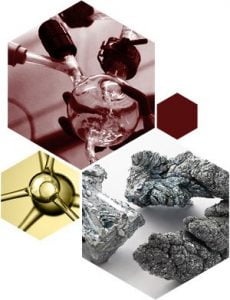
Calcium Fluoride, anhydrous
Properties
- We can offer items in bulk or custom. For other quantities or purities, please request a quotation.
- All prices are subject to change.
Related Products
Information about Calcium Fluoride, anhydrous / CAS 7789-75-5
Calcium Fluoride (CaF₂) is a widely used inorganic compound known for its excellent thermal stability, low solubility, and unique optical properties. Naturally occurring as the mineral fluorite, it is utilized across multiple industries and research fields, including optics, metallurgy, biomedical research, and environmental science. Due to its high chemical durability, broad optical transmission range, resistance to radiation, and other unique metallurgical and chemical properties, it serves as a crucial material in a broad range of industrial applications.
In the optics and photonics industry, Calcium Fluoride is used extensively in the manufacturing of lenses, prisms, and optical windows for ultraviolet (UV) and infrared (IR) applications. It possesses a low refractive index and high transparency, making it a vital component in spectroscopy, laser optics, and lithography systems. Recent advancements in nanotechnology have enabled the development of CaF₂ coatings for improving the efficiency and durability of optical and electronic devices. Additionally, Calcium Fluoride’s resistance to high-energy radiation makes it indispensable in space and defense technologies where robust optical materials are required.
The biomedical field has also leveraged Calcium Fluoride’s unique properties, particularly in imaging and diagnostic applications. Research has demonstrated its effectiveness in fluoride-based bioimaging, including its use in bimodal ultrasound and X-ray imaging. Additionally, CaF₂ nanoparticles have been incorporated into dental materials due to their antibacterial properties and ability to release fluoride ions, aiding in the remineralization of tooth enamel and the prevention of cavities.
In materials science and nanotechnology, Calcium Fluoride is being explored for its role in coatings, lubricants, and high-performance ceramics. Its incorporation into nanocomposite materials enhances mechanical strength and durability, making it an ideal component for protective coatings for aerospace and industrial applications. Additionally, its anti-reflective properties are valuable in high-performance coatings for lenses and sensors.
- Hahn, D. (2014). Calcium fluoride and barium fluoride crystals in optics: multispectral optical materials for a wide spectrum of applications. Optik & Photonik, 9(4), 45-48.
- Song, Q., Cai, J., Wang, C., Zhou, L., Chen, Y., Zhou, M., … & Ou, X. (2024). Wafer-scale fabrication of single-crystalline calcium fluoride thin-film on insulator by ion-cutting. Optical Materials, 157, 115787.
Safety
- H303 May be harmful if swallowed.
- H315 Causes skin irritation.
- H319 Causes serious eye irritation.
- H335 May cause respiratory irritation.
- P261 Avoid breathing dust/fume/gas/mist/vapours/spray.
- P271 Use only outdoors or in a well-ventilated area.
- P280 Wear protective gloves/protective clothing/eye protection/face protection.
- P302+P352 IF ON SKIN: wash with plenty of soap and water.
- P304+P340 IF INHALED: Remove victim to fresh air and Keep at rest in a position comfortable for breathing.
- P305+P351+P338 IF IN EYES: Rinse cautiously with water for several minutes. Remove contact lenses, if present and easy to do. Continue rinsing.
- P403+P233 Store in a well-ventilated place. Keep container tightly closed.


